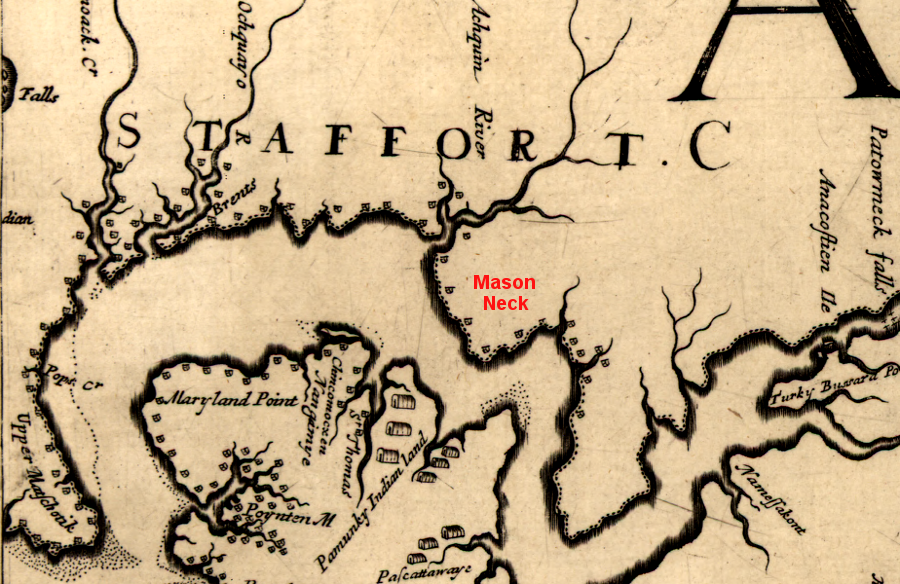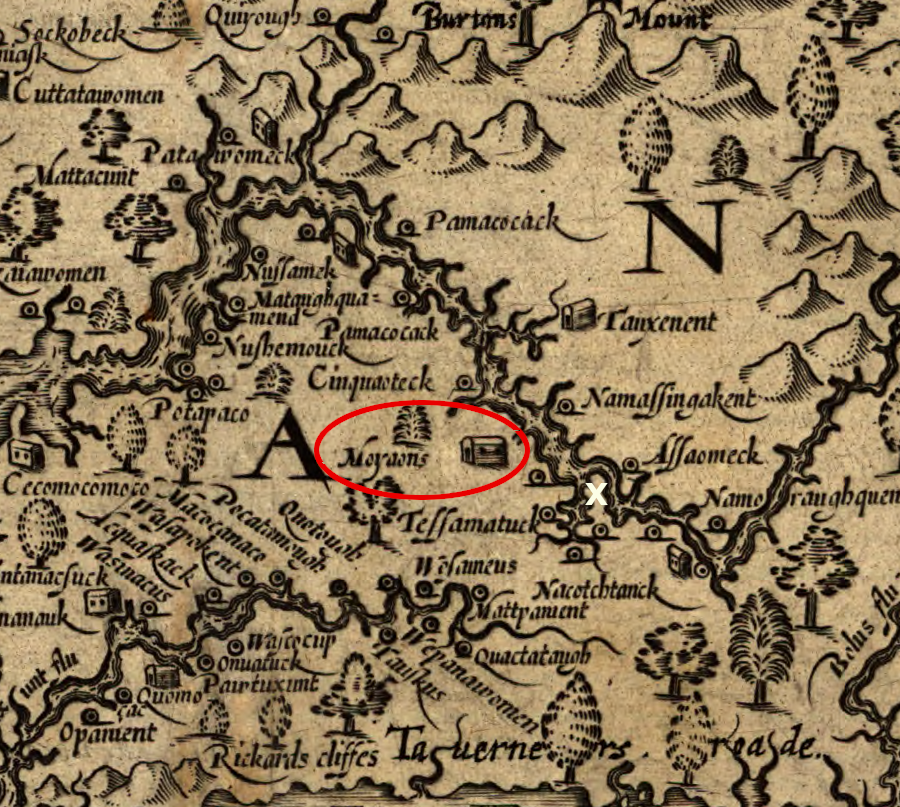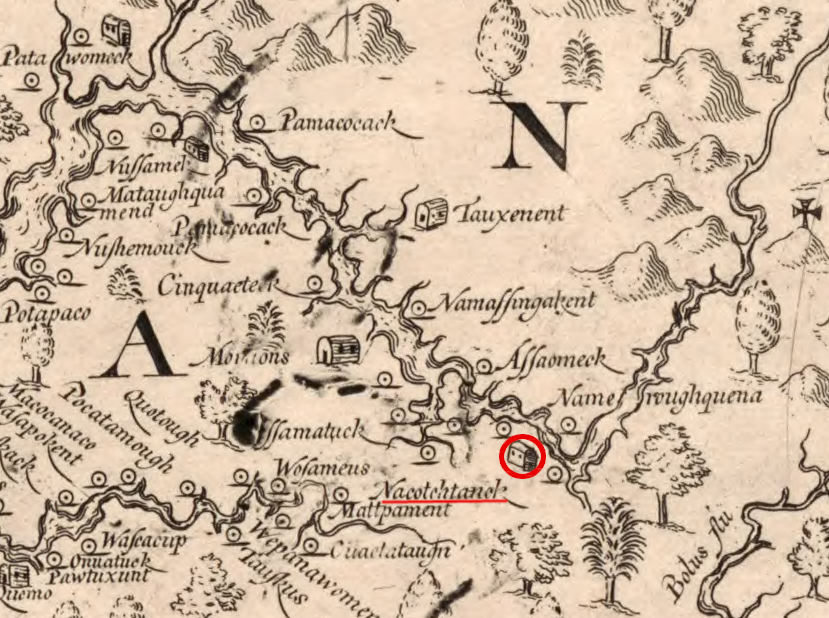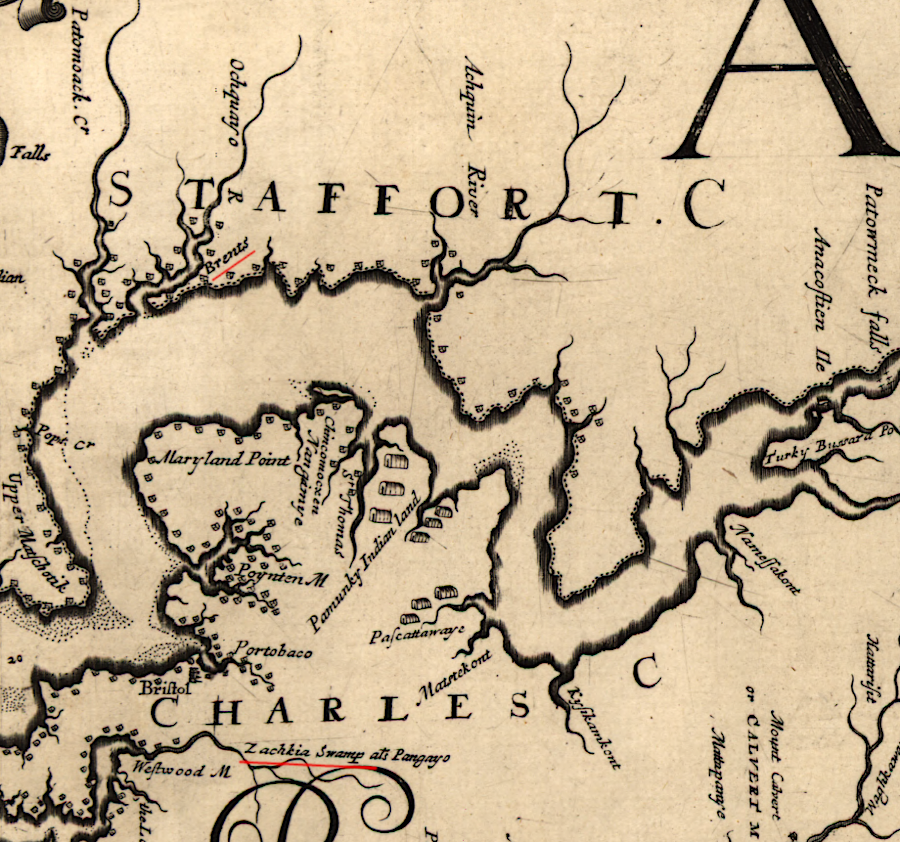Piscataway/Conoy in Virginia

a 1670 map recorded settlements of the Piscataway and remnants of the tribes in Powhatan's paramount chiefdom, across the Potomac River from the Occoquan (Achquin) River
Source: Library of Congress, Virginia and Maryland as it is planted and inhabited this present year 1670 (by Augustine Herrman)
When the English arrived in Virginia, there were roughly 5,000 members of the Piscataway nation living along the Potomac River.
The Europeans discovered that the Piscataway tayac was a paramount chief similar to Powhatan. The tayac's span of control included what today is southern Maryland west of the Chesapeake Bay. Land on the west side of the Potomac River, occupied by the Moyumpse (Dogue), may also have been part of the tayac's territory. The tayac's capital was at Moyaone near Piscataway Creek, and each town under his authority was governed by werowances, war chiefs, priests and shamans.1

the Piscataway tayac "kings house" was at Moyaone near Piscataway Creek, when John Smith explored the area in 1608 (white X is now Washington DC)
Source: Library of Congress, Virginia (by John Smith, 1624)
The Piscataway may have evolved from a group that migrated down the Potomac River between 1300-1400AD. According to the Montgomery Hypothesis, a group living along the Potomac River between the Blue Ridge and the Fall Line was displaced by others who moved into the region from the north. The displaced group - the Montgomery complex people - moved downriver from the Piedmont to the other side of the Fall Line. At the same time, people sharing the Mason Island culture were displaced from the Potomac River valley upstream of the Blue Ridge and forced to move into the Virginia Piedmont south of the river.
The migrants forced down below Great Falls established new towns on the eastern side of the Potomac River, on Accokeek and Potomac creeks in Virginia, and later in the Mason Neck region. They evolved into the Piscataway, an Algonquian-speaking with close ties to the Patawomeck.
They actively traded with the closely-allied Nacotchtank and other tribes on the Eastern Shore. The 300 members of the Nacotchtank tribe occupied several villages along the Potomac and the Anacostia rivers near their confluence.

John Smith documented the chief town of the Nacotchtank near the mouth of the Anacostia River
Source: Library of Congress, Virginia (by John Smith, 1624)
According to one story told by the brother of the tayac in 1660, the first tayac came from the Eastern Shore thirteen generations before the first English immigrants into Maryland.2
Colonists sailed to the new colony of Maryland on the Ark and Dove, and arrived at St. Clemet's Island on March 25, 1634. They dealt initially with Wannas, the head chief. The first Maryland settlement of St. Mary's City was in territory of the Yaocomaco, who paid tribute to Wannnas. Governor Calvert negotiated successfully for the right to occupy the land.
The English were welcomed because the Piscataway were losing territory and population in their competition with the Susquehannock, who may have been the descendants of the northern group that originally forced migrations out of the Potomac River valley in 1300-1400 AD.3
The Maryland colonists gained control over the selection of the Piscataway tayac (leader) by 1641. In 1666, after Iroquois raids had reduced the population and weakened the tribe's ability to defend itself, the tayac signed "Articles of Peace and Amity" which affirmed their subordinate status to the Maryland colonists.
The treaty did guarantee hunting and fishing rights including:4
- The Priviledge of Hunting, Crabbing, fishing, And fowling shal be preserved to the Indians Inviolably
Two years later, the Maryland colony signed a similar treaty with the Nanticoke tayac Unnacokasimmon. Despite four more treaties and designation of reservations for the Nanticoke, colonists continued to encroach on Nanticoke territory and constrained their ability to travel for winter hunts. In 1744, most members of the Nanticoke moved north to join the Iroquois or east into Delaware.5

the Piscataway lived across the Potomac River in Maryland, but that did not stop the Brents and other settlers in Stafford County from attacking the fort in Zekiah Swamp
Source: Library of Congress, Virginia and Maryland as it is planted and inhabited this present year 1670 (by Augustine Herrman)
In 2019, the Piscataway Indian Nation and the Piscataway Conoy Tribe, which was recognized officially by the state of Maryland in 2012, requested that the District of Columbia issue free fishing licenses to all members. Fish from the Anacostia and Potomac rivers within the District boundaries were not viewed as safe to eat, but the request was intended primarily to highlight Native American identify in the region. The DC City Council approved legislation granting the request in 2020.
One member of the tribe fished regularly at Quantico. Depending upon where her line was in the water, she might be fishing in a cove within the boundaries of Virginia rather than in the Potomac River located within Maryland. She purchased a license to eliminate any question regarding the right to fish, but was fond of alerting conservation officers that under the terms of the 1666 treaty, she did not need one.6
Links
References
1. Alex J. Flick, Skylar A. Bauer, Scott M. Strickland, D. Brad Hatch, Julia A. King. "...a place now known unto them:" The Search for Zekiah Fort, St. Mary's College of Maryland, 2012, pp.11-14, https://www.academia.edu/2484589/_A_Place_Now_Known_Unto_Them_The_Search_for_Zekiah_Fort_by_Alex_J._Flick_Skylar_A._Bauer_Scott_M._Strickland_D._Brad_Hatch_and_Julia_A._King; "Unearthing Native American history on an island in Southern Maryland," Washington Post, November 7, 2022, https://www.washingtonpost.com/history/2022/11/07/native-americans-st-clements-island/
2. Stephen Potter, Commoners, Tribute, and Chiefs: The Development of Algonquian Culture in the Potomac Valley, University of Virginia Press, 1994, p.132, pp.137-138, https://www.google.com/books/edition/Commoners_Tribute_and_Chiefs/IWQfeDJYlewC; "A Native American tribe once called D.C. home. It’s had no living members for centuries," Washington Post, November 22, 2018, https://www.washingtonpost.com/history/2018/11/22/native-american-tribe-once-called-dc-home-its-had-no-living-members-centuries/ (last checked November 1, 2020)
3. Skylar A. Bauer, Julia A. King, Scott M. Strickland, "Archaeological Investigations at Notley Hall Near Chaptico, Maryland," St. Mary's College of Maryland, 2013, p.6, https://www.academia.edu/10311813/Archaeological_Investigations_at_Notley_Hall_Near_Chaptico_Maryland (last checked November 18, 2016)
4. Anna Coxe Toogood, "General Historic Background Study, Piscataway Park, Maryland," National Park Service, September 1969, p.46, p.146, http://npshistory.com/publications/pisc/gen-hist-background.pdf (last checked September 8, 2020)
5. "History," the Nanticoke Indian Tribe, https://www.nanticokeindians.org/page/history; "Our Tribal History," The Nanticoke Lenni-Lenape, https://nanticoke-lenape.info/history.htm; "Lost Tribes Of The Eastern Shore," Washington Post, September 1, 1991, https://www.washingtonpost.com/archive/opinions/1991/09/01/lost-tribes-of-the-eastern-shore/fcbe2ead-f7bd-45b8-a105-3d65ae4115ad/ (last checked February 7, 2021)
6. "D.C. bill would honor 17th-century treaty by granting Native Americans free fishing licenses," Washington Post, November 27, 2019, https://www.washingtonpost.com/local/dc-politics/dc-bill-would-honor-17th-century-treaty-by-letting-native-americans-fish-for-free/2019/11/27/94eedbe0-0fab-11ea-b0fc-62cc38411ebb_story.html; "D.C. Council votes to rename Lafayette rec center and park, honor long-ignored Indian treaty," Washington Post, December 1, 2020, https://www.washingtonpost.com/local/dc-politics/dc-renaming-lafayette-pointer/2020/12/01/5ac2442a-334f-11eb-a997-1f4c53d2a747_story.html (last checked December 2, 2020)
"Indians" of Virginia - the Real First Families of Virginia
Exploring Land, Settling Frontiers
Virginia Places



